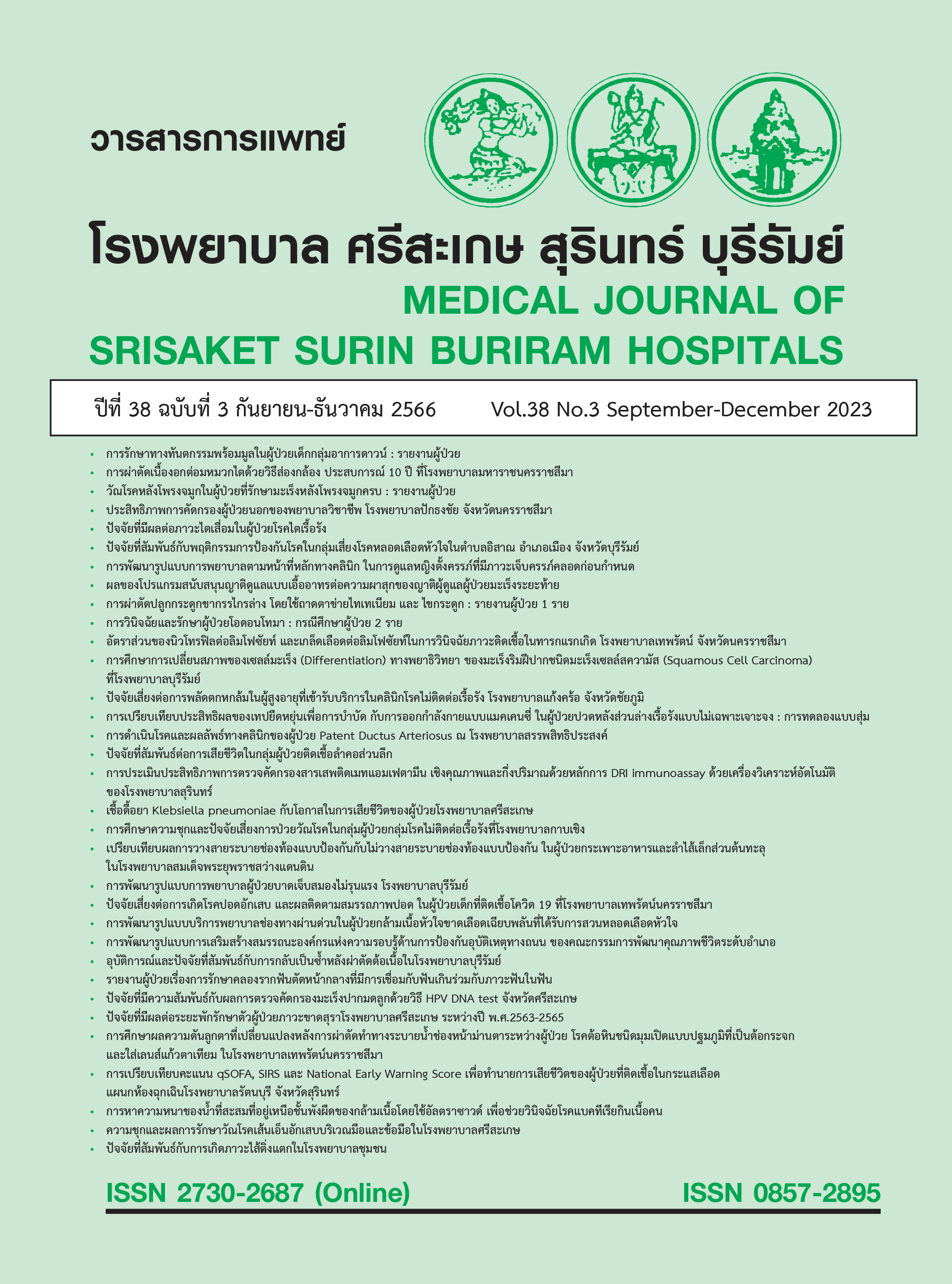การดำเนินโรคและผลลัพธ์ทางคลินิกของผู้ป่วย Patent Ductus Arteriosus ณ โรงพยาบาลสรรพสิทธิประสงค์
Main Article Content
บทคัดย่อ
หลักการและเหตุผล: Patent ductus arteriosus(PDA) หรือเส้นเลือดหัวใจเกิน เป็นหนึ่งในโรคหัวใจพิการแต่กำเนิดที่พบมากในเด็ก มีการดำเนินของโรคหลายแบบ แต่ในโรงพยาบาลสรรพสิทธิประสงค์ยังไม่พบว่ามีการศึกษาข้อมูลเกี่ยวกับการดำเนินของโรค การรักษาและผลลัพธ์มาก่อน
วัตถุประสงค์: เพื่อศึกษาข้อมูลพื้นฐานและอาการแสดงของผู้ป่วย PDA ปัจจัยที่มีผลต่อการปิดของ PDA และผลลัพธ์ของการรักษาด้วยวิธีการต่างๆในผู้ป่วยที่ได้รับการวินิจฉัยและรักษาครั้งแรกที่อายุน้อยกว่า 15 ปี
วิธีการศึกษา: เป็นการศึกษาย้อนหลังเชิงพรรณนา โดยทำการทบทวนเวชระเบียนผู้ป่วยในคลินิกโรคหัวใจเด็กที่ได้รับการวินิจฉัย PDA เพียงอย่างเดียวระหว่าง 1 มกราคม พ.ศ.2548 ถึง 31 ธันวาคม พ.ศ.2557
ผลการศึกษา: มีผู้ป่วย 384 คน ค่ามัธยฐานของอายุในการวินิจฉัย 30 วัน(1-5,232) เพศหญิง 227 คน(ร้อยละ 59.1) มีความผิดปกติทางโครโมโซมร่วมด้วย 60 คน(ร้อยละ 15.6) ส่วนใหญ่เป็นกลุ่มอาการดาวน์ (ร้อยละ 96.7) มีอาการหัวใจล้มเหลว 211 คน(ร้อยละ 54.9) ได้รับการรักษาด้วยการปิดเส้นเลือด 153 คน(ร้อยละ 39.8) มีอัตราการปิดสำเร็จในครั้งเดียวร้อยละ 96.7 (148 คน) โดยใช้อุปกรณ์ปิด104 คน (ร้อยละ 70.3) และผ่าตัดปิด 44 คน(ร้อยละ 29.7) มี 5 คน (ร้อยละ 3.3) ที่ต้องปิดซ้ำ ทั้งหมดนี้ไม่มีภาวะแทรกซ้อนที่รุนแรง ผู้ป่วยมีการปิดของเส้นเลือดได้เอง 143 คน(ร้อยละ 37.2) มีค่ามัธยฐานของอายุ 220 วัน (30-6,589) โดยพบความสัมพันธ์ของขนาดเฉลี่ย ≤3 มิลลิเมตร(เมื่อเทียบกับขนาด เฉลี่ย >3 มิลลิเมตร) จะมีโอกาสปิดเองเพิ่มเป็น 5 เท่า(95% CI= 2.05-12.49)
สรุป: การดำเนินโรคของผู้ป่วย PDA สามารถปิดได้เองร้อยละ 37.2 โดยมีขนาด PDA เฉลี่ยขณะวินิจฉัยน้อยกว่ากลุ่มที่ยังไม่สามารถปิดเองอย่างมีนัยสำคัญ โดยพบว่าเมื่อ PDA มีขนาดน้อยกว่า 3 มิลลิเมตรเป็นปัจจัยทำนายว่ามีโอกาสปิดเองเพิ่มเป็น 5 เท่า การรักษาขึ้นอยู่กับอาการทางคลินิกของผู้ป่วย ถ้าพิจารณาแล้วจำเป็นต้องปิดเส้นเลือด การตัดสินใจปิดโดยการผ่าตัดหรือใช้อุปกรณ์ปิดขึ้นอยู่กับลักษณะของเส้นเลือด อาการทางคลินิก อายุและน้ำหนักของผู้ป่วย และการยอมรับในวิธีการรักษาของญาติ โดยการรักษาทั้งสองวิธีได้ผลดีมีอัตราการปิดสำเร็จสูง และไม่มีภาวะแทรกซ้อนที่รุนแรง
Article Details

อนุญาตภายใต้เงื่อนไข Creative Commons Attribution-NonCommercial-NoDerivatives 4.0 International License.
เอกสารอ้างอิง
Schneider DJ, Moore JW. Patent ductus arteriosus. Circulation 2006;114 (17):1873-82. doi: 10.1161/CIRCULATIONAHA.105.592063.
Moore P, Brook MM. Patent ductus arteriosus and Aortopulmonary window. In: Allen HD, Driscoll DJ, Shaddy RE, Feltes TF, editors. Moss and Adams’ Heart disease in infants, children, and adolescents. Philadelphia : Lippincott Williams & Wilkins ; 2013: 722-45.
Park MK. Left-to-right shunt lesions. In: Park MK. Pediatric cardiology for practitioners. 5th. ed. Philadelphia : Mosby ; 2008 : 161-91.
Keane JFB, Fyler DC, Lock JE. Patent Ductus Arteriosus. In: Teele SA, editors. Nadas’ Pediatric Cardiology. Philadephia : Elsevier Inc. ; 1992 : 617-25.
Schneider DJ. The patent ductus arteriosus in term infants, children, and adults. Semin Perinatol 2012;36 (2):146-53. doi: 10.1053/j.semperi.2011.09.025.
Hoffman JI, Kaplan S. The incidence of congenital heart disease. J Am Coll Cardiol 2002;39 (12):1890-900. doi: 10.1016/s0735-1097 (02)01886-7.
Reller MD, Strickland MJ, Riehle-Colarusso T, Mahle WT, Correa A. Prevalence of congenital heart defects in metropolitan Atlanta, 1998-2005. J Pediatr 2008;153 (6):807-13. doi: 10.1016/j.jpeds.2008.05.059
Khongphatthanayothin A, Mungminsak S, Lertsupcharoen P, Chotivitayatarakorn P, Thisyakorn C. Congenital heart disease in Thai children: Classification based on the New England Regional Infant Cardiac Program. Asean Heart J 2001;8:1-5.
สุขุมาล สิริพันธนะ. โรคหัวใจในผู้ป่วยเด็ก. วารสารการแพทย์โรงพยาบาลศรีสะเกษ สุรินทร์ บุรีรัมย์ 2555;27(3):235-42.
Ferencz C, Neill CA, Boughman JA, Rubin JD, Brenner JI, Perry LW . Congenital cardiovascular malformations associated with chromosome abnormalities: an epidemiologic study. J Pediatr 1989;114 (1):79-86. doi: 10.1016/s0022-3476 (89)80605-5.
Park SC, Mathews RA, Zuberbuhler JR, Rowe RD, Neches WH, Lenox CC. Down syndrome with congenital heart malformation. Am J Dis Child 1977;131 (1):29-33. doi: 10.1001/archpedi. 1977.02120140031003.
Campbell M. Natural history of persistent ductus arteriosus. Br Heart J 1968;30 (1):4-13. doi: 10.1136/hrt.30.1.4.
อภิชัย คงพัฒนะโยธิน. โรคหัวใจพิการแต่กำเนิด. ใน: อภิชัย คงพัฒนะโยธิน, พีระพัฒน์ มกรพงศ์, บรรณาธิการ. ภาวะวิกฤตทางหัวใจในเด็ก : รวมถึงการดูแลเด็กหลังผ่าตัดรักษาโรคหัวใจแต่กำเนิด. กรุงเทพฯ : อมรินทร์พริ้นติ้งแอนด์พับลิชชิ่ง ; 2551 : 1-32.
สุกษม อัตนวานิช. Patent ductus arteriosus. ใน: สุกษม อัตนวานิช, บรรณาธิการ. โรคหัวใจพิการแต่กำเนิด. กรุงเทพฯ : ไอเดีย อินสแตนท์ พริ้นติ้ง ; 2552 : 37-48.
Feltes TF, Bacha E, Beekman RH 3rd, Cheatham JP, Feinstein JA, Gomes AS, et al. Indications for cardiac catheterization and intervention in pediatric cardiac disease: a scientific statement from the American Heart Association. Circulation 2011;123 (22):2607-52. doi: 10.1161/CIR.0b013e31821b1f10.
Baruteau AE, Hascoët S, Baruteau J, Boudjemline Y, Lambert V, Angel CY, et al. Transcatheter closure of patent ductus arteriosus: past, present and future. Arch Cardiovasc Dis 2014;107 (2):122-32. doi: 10.1016/j.acvd.2014.01.008.
Chen Z, Chen L, Wu L. Transcatheter amplatzer occlusion and surgical closure of patent ductus arteriosus: comparison of effectiveness and costs in a low-income country. Pediatr Cardiol 2009;30 (6):781-5. doi: 10.1007/s00246-009-9440-3.
Zulqarnain A, Younas M, Waqar T, Beg A, Asma T, Baig MA. Comparison of effectiveness and cost of patent ductus arteriosus device occlusion versus surgical ligation of patent ductus arteriosus. Pak J Med Sci 2016;32 (4):974-7. doi: 10.12669/pjms.324.10048.
Prieto LR, DeCamillo DM, Konrad DJ, Scalet-Longworth L, Latson LA. Comparison of cost and clinical outcome between transcatheter coil occlusion and surgical closure of isolated patent ductus arteriosus. Pediatrics 1998;101 (6):1020-4. doi: 10.1542/peds.101.6.1020.
Dutta S, Mihailovic A, Benson L, Kantor PF, Fitzgerald PG, Walton JM, et al. Thoracoscopic ligation versus coil occlusion for patent ductus arteriosus: a matched cohort study of outcomes and cost. Surg Endosc 2008;22 (7):1643-8. doi: 10.1007/s00464-007-9674-1.
จิรณัฏ พวงแก้ว. ผลการรักษาของเส้นเลือดหัวใจเกินในโรงพยาบาลหัวหิน. วารสารกุมารเวชศาสตร์ 2559;56 ( (1):33-41.
Krichenko A, Benson LN, Burrows P, Möes CA, McLaughlin P, Freedom RM. Angiographic classification of the isolated, persistently patent ductus arteriosus and implications for percutaneous catheter occlusion. Am J Cardiol 1989;63 (12):877-80. doi: 10.1016/0002-9149 (89)90064-7.
El-Said HG, Bratincsak A, Foerster SR, Murphy JJ, Vincent J, Holzer R, et al. Safety of percutaneous patent ductus arteriosus closure: an unselected multicenter population experience. J Am Heart Assoc 2013;2(6):e000424. doi: 10.1161/JAHA.113.000424.
สรวิชญ์ พงศ์พิทยุตม์. การรักษาโรคเส้นเลือดหัวใจเกินโดยการปิดด้วยอุปกรณ์ผ่านทางสายสวนหัวใจ. วารสารกุมารเวชศาสตร์ 2557;53 (2):118-27.
Lam JY, Lopushinsky SR, Ma IWY, Dicke F, Brindle ME. Treatment Options for Pediatric Patent Ductus Arteriosus: Systematic Review and Meta-analysis. Chest 2015;148 (3):784-93. doi: 10.1378/chest.14-2997.


